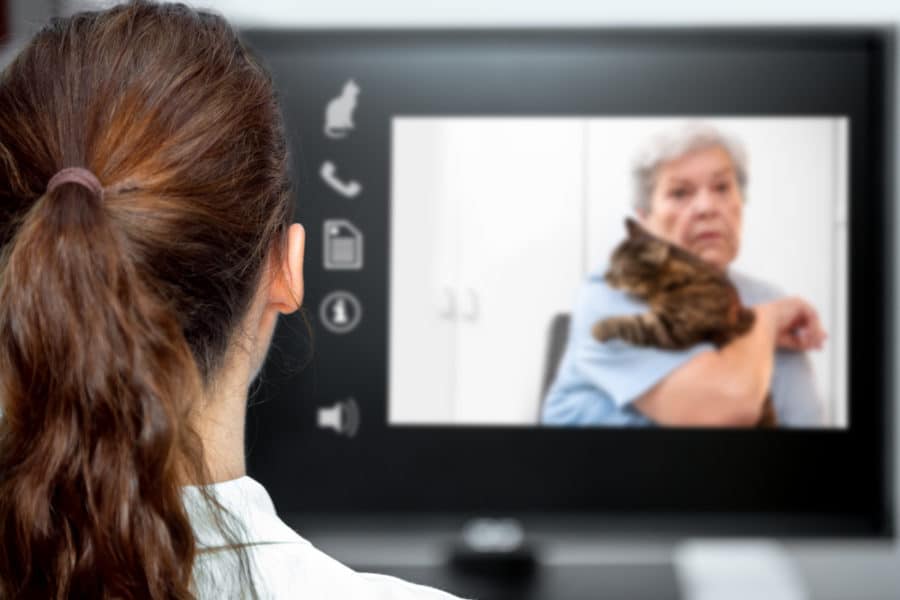Advancements such as telemedicine are on the rise in the veterinary world – and with good reason. Gaining a deeper understanding of these technologies and their benefits will help you integrate them smoothly into your clinic.
The veterinary industry is changing, and rapidly. Increased pandemic wait times drive a wedge between vets and clients, and a pets’ health can’t always wait. In response, many vets have started to ask what parts of their service can take place online, and the answer has led to some promising developments. Telemedicine is a time-saving, cost-saving, profit-boosting measure that can put a veterinary practice on the cutting edge.
What is telemedicine?
In the most basic terms, telemedicine is a digital consultation (like a Zoom call) with a vet or a vet tech. Provided that there is an established relationship with a client, veterinarians can assess patients and prescribe medication via a digital consultation. A vet might diagnose a pet during one of these consultations, or they might decide a pet needs to be seen in person. In fact, 70% of digital consultations lead to an in-person visit within the next two months. These follow-up appointments tend to be quicker, since the vet already has a good idea of how to address the problem.
Veterinarians have to deal with a massive backlog of patients, making time spent with each patient even more precious. Telemedicine allows vets to charge more efficiently for their time — veterinarians should be compensated for all of the time they spend attending to patients, even if it’s just offering advice over the phone. Vet techs can handle patient triage, allowing for practices to manage their workflows more effectively. This isn’t just for the benefit of vets, since it also ensures that each pet will get what they need more quickly.
Telemedicine allows veterinary practices to move away from clunky fax machines and unwieldy file cabinets. Medical recordkeeping has gotten considerably more sophisticated in the past ten years, and telemedicine platforms like TeleTails make it far quicker and easier to access essential, life-saving information in digitized patient records. Vets can also store their consultations on the TeleTails platform, so they can easily review their prior appointments.
Telemedicine is just the beginning
Telemedicine helps veterinary practices make more money, giving them the freedom to invest more in their clinic’s equipment. And vets who adopt telemedicine are probably already thinking about what other technological advances they want to add. These are some of the most interesting developments in 21st century veterinary technology, and all are a little closer within reach with the addition of telemedicine appointments.
What’s next for your veterinary practice?
Endoscopic surgery
As vets already know, endoscopic surgery creates smaller incisions and offers the benefit of a shorter recovery, improved pulmonary function, and lower rates of hypoxemia. Gastrointestinal endoscopy is one of the most common uses of this type of surgical equipment, although this type of surgery has a lot of undiscovered potential. It has also proven useful in removing complex nephroliths, and this type of surgery’s utility has led to an increase in purely exploratory surgeries.
Video otoscope
Otoscope is a type of endoscopic surgery that examines the ear canal. Video otoscopes display the footage on the computer screen, where the client can see exactly what’s happening in their pet’s ear — sometimes an unpleasant revelation. Seeing a pet’s dirty ear canal can drive home just how gross infected ears can get, and offer great motivation to keep pets’ ears clean.
3D Echocardiography
Not everything can be captured in an X-Ray or an MRI scan due to the fact that animals have smaller hearts than humans that beat considerably faster. 3D Echocardiography has helped make major advances in diagnostic imaging, and it is set to expand those abilities even further. For instance, this type of technology has recently demonstrated its usefulness in the evaluation of cardiac masses in dogs.
Digital radiography
Is your practice ready for an upgrade from computed to digital radiography? For vets who are able to invest in their practice’s equipment, digital radiography can shorten the turnaround time for an X-ray. Though computed radiography costs less, there is more labor involved in digitizing the X-ray – cassettes need to be removed from the machine and then scanned. Digital radiography, on the other hand, makes it easier and faster to produce a high-quality image. Though it’s significantly more expensive to set up, prices have dropped significantly in the past decade.
Data collection
High-tech pet accessories are on the rise, and some of these can help vets diagnose potential medical issues. GPS-enabled collars help ensure dogs get enough exercise, and vets can use this information to see if a pet has had a major reduction in energy, an important clue that something isn’t right.
The practitioner-client relationship
A lot has changed in veterinary medicine, but the fact still remains – the relationship between vets and clients is just as important as ever. Telemedicine has the power to get vets and clients all on the same page, even when they’re miles apart. Examining data from their collar, or asking a client for their help to examine a pet during a digital consultation, all underline the fact that vets and clients can work as a team to improve pets’ quality of life.
[pro_ad_display_adzone id=”31539″]



